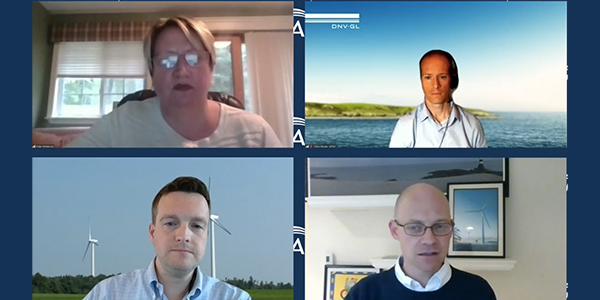A discussion at the American Wind Energy Association Offshore Windpower Virtual Summit on Tuesday reinforced the argument that a planned transmission network for offshore wind would be more beneficial than the current every-project-for-itself approach.
But it also brought urgency to the issue. The benefits of an offshore network decreases with each project that interconnects by itself, said James Cotter, Shell general manager of U.S. offshore wind. And “an individual project that has a route to market or has its permits in hand doesn’t want to be held up by waiting for the bigger, better solution, so it will run itself.”
State and federal planning regulators are in the process of choosing between developers building their own generator lead lines — the radial system — or independent transmission construction and ownership, the network system. “If they’re all radial connections at AC … for 2 GW or 4 GW, you might end up with a difference of six to 12 cables routing through, whereas if you could use HVDC in a coordinated way, you only have two to three cables coming in,” Cotter said. “Once you’ve laid a cable, in some of the approaches, it makes it very hard, if not impossible, to lay another project’s set of cables in proximity to that; it’s a very constrained area.”

Clockwise from top left: Kate McKeever, RWE; Christopher Hayes, DNV GL; James Cotter, Shell; and Zach Smith, NYISO | AWEA
The U.S. has an “amazing, perishable opportunity of saying, ‘How do we optimize transmission across the RTOs and ISOs, across the states, to enable cost-effective volume that will bring the industry here?’” Cotter said.
Zach Smith, NYISO vice president for system and resource planning, said transmission planning takes time, as planners must consider all options and at the same time.
“We do not do top-down planning; we don’t dictate solutions. We turn to our market and what the market wants to do,” Smith said. “One alternative is we turn to the state … and what public policies do they see as driving the need for transmission. If they declare there is a transmission need driven by public policy, then we act on that.”
New York hosted a technical conference on transmission for renewable resources on Oct. 9, where Smith told state officials that without coordinated planning, transmission congestion around New York City could increase after the first 6,000 MW of offshore wind is interconnected. (See OSW Growth to Test New York’s Transmission Grid.)
In terms of interregional planning, a Northeastern planning protocol was “beefed up” after Order 1000 to improve coordination among ISO-NE, NYISO and PJM, Smith said. The Inter-Regional Planning Stakeholder Advisory Committee (IPSAC) meets regularly to explore opportunities for joint transmission development, but “thus far, nothing has come up in terms of some definitive project.”

Zach Smith, NYISO | AWEA
Massachusetts hosted a technical conference in March before officials decided they should not this year solicit proposals for a transmission network for offshore wind generation. Developers have proposed interconnecting up to 1,200 MW at various points along the southern New England coast, from Barnstable and Brayton Point in Massachusetts, to Kingston, R.I., and Montville, Conn. (See Mass. DOER Explores Transmission for OSW.)
Moderator Kate McKeever, director of government and regulatory affairs for U.S. offshore wind at German utility RWE, asked what constraints offshore wind would cause for onshore transmission.
Given that offshore wind will be injecting directly to load centers in New York City and Long Island, Smith said it will alleviate some of the transmission constraints upstate, “but there are going to be plenty of times a year when the amount of power coming in from offshore greatly exceeds whatever amount of load is in that local area, and you’re going to need transmission facilities to get that power either off Long Island or out of the New York City area.”
“We already were seeing constraints within the New York City and Long Island area,” he said. “It’s just natural that the power will want to flow out … and up into the rest of New York and then across the Eastern Interconnection, so you’ll need transmission investment in those areas to unbottle the constrained renewable resources.”
Such investment would obviously help ratepayers in New York, he said, but “it ultimately turns into an East Coast issue where everyone could benefit, and no matter what, you have to overcome those transmission constraints from a legacy grid that was not designed to deliver that kind of power.”


